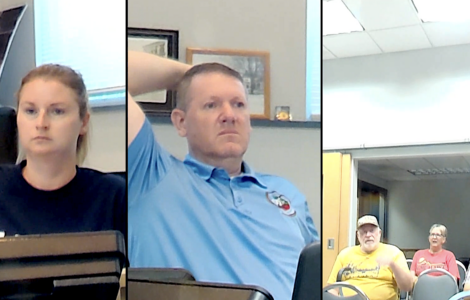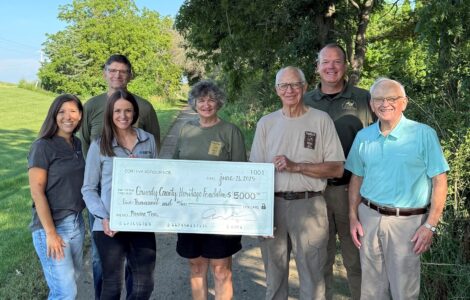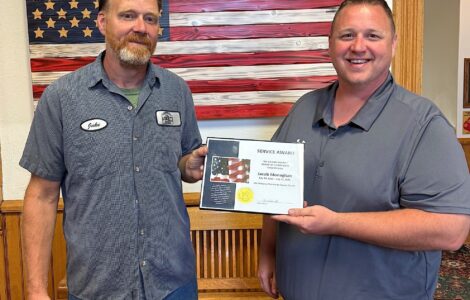Tama Co. farm hosts cover crop event
Women, Land and Legacy returns after 19 month hiatus

NRCS Resource Conservationist Tina Cibula chats with Bob Murty of Gladbrook (center) and Calvin Dostal of Traer (left) during a cover crop workshop put on by Tama County Women, Land and Legacy on Aug. 31 at the Murty farm outside of Gladbrook. Photo by Darvin Graham
The Tama County chapter of the Women, Land and Legacy organization returned to action this week for their 39th event in Tama County since their founding in 2007.
The group, which is a USDA education and outreach program seeking to empower female landowners and farmers, normally holds four events each year in conjunction with changing seasons.
With the COVID-19 pandemic altering the course of the last year and a half, the group had not met since January 2020.
Under a picturesque late summer sky, more than a dozen people from all parts of the county gathered on Aug. 31 at the farm of Steve and Erin Murty in rural Gladbrook to learn about the benefits of cover crops and to discuss with each other how different cover crop strategies are going across the area.
With the implementation of the USDA’s Sustainable Agriculture Research and Education (SARE) program in the 1990s, cover crop usage has continued to gain popularity around the country and in Iowa for a number of collaborative benefits provided to farmer’s bottom line and to the environment.

Tina Cibula displays a dirt sample after conducting a rainfall simulator demonstration at a cover crop workshop in Gladbrook. Cover crops allow soil to be more resilient in the face of drastic weather events like a drought or flood. Photo by Darvin Graham
According to a NRCS conservation guide, cover crops such as cereal rye, oats and winter wheat are planted to temporarily protect the ground from wind and water erosion and to supply living roots to the soil during times when cropland is often not adequately protected.
NRCS Resource Conservationist and Tama County livestock producer Tina Cibula opened the Tuesday workshop with a presentation about the different species of cover crops, the unique characteristics and benefits each plant offers to a field, recommended target dates for seeding of the various species and the variety of application methods producers use to get cover crop seeds in the ground.
Among the benefits of cover crops is the ability to make the soil within farm fields more resilient to weather events. The plants used for cover crops help bind soil together so it will hold moisture longer in the event of a drought. The roots of the plants also penetrate through compacted soil to provide aeration which helps water to be absorbed into the ground through heavy rain events.
Two other key benefits of cover crops discussed at the workshop were the ability to assist with weed control as well as provided grazing and silage for livestock.
In both cases, producers are able to decrease outside interventions within their operations by simply planting more seeds.

Doug Roberts of rural Garwin introduced himself at the Cover Crop workshop put on by Tama Women, Land & Legacy at the Murty farm near Gladbrook on Aug. 31. Photo by Darvin Graham
Cover crops fill the soil, making it harder for weeds to spread which means less time and investment producers have to put toward spraying herbicides.
Livestock producers can also use cover crop fields for their cattle to graze on or for silage to use during the winter, which means less investment in packaged feed during the winter months.
The Murtys have been using cover crops in their family operation for around 20 years, when Steve’s father Bob first began implementing them in their fields.
The idea initially was to use cover crops for added plants that the Murty’s cattle could graze on. They calculated the more resources they were able to produce on their farms for their own operation, the less they would have to pay in feed costs.
Steve said through their experience with cover crops, they’ve always been able to yield positive amounts of forage for livestock while not jeopardizing their cash crops.
In recent years they’ve experimented with planting multiple species of cover crop plants to give their overall cover crop profile different benefits.
“It’s all about understanding your goals and being able to define what success looks like in a particular field,” Murty said.
Some cover crop species do better with colder temperatures and can be planted later in the season. Others are particularly adept at weed control or will handle shade better than others.
This year the Murtys are using a mixture of five different species of cover crops in their fields. They even have a species of bean growing alongside their rows of corn which they hope will add a boost of protein for their livestock when they use the cover crop for grazing or silage.
Following her presentation, Cibula led the group through a rainfall simulator exercise that demonstrated how rain water interacts with different selections of soil that have undergone practices such as no-till farming, cover crops and prescribed grazing.
Cibula said for producers considering beginning a new practice with cover crops, the best advice is to start small and be patient. Testing out new species or new methods on a field can be less risky when done on one or two strips rather than an entire field at once.
Cibula also encouraged new cover crop producers to think ahead and plan as best they can which method of seeding and of termination will work best for their field system.
She also said the local NRCS and USDA office in Tama County is an excellent resource for assistance in planning new cover crop practices.
As of this week, financial assistance through the USDA cover crop cost share program is still available for fall 2021. Those interested can reach the NRCS office in Toledo at 641-484-2702.
Following the rainfall demonstration the Murtys led the group to a nearby corn field where they showed how the cover crops were growing alongside their corn.
Jack Boyer of Reinbeck was also on-hand for a discussion about application methods for cover crop. Boyer is a NACD Soil Health Champion who utilizes no-till, strip-till and cover crop practices on his century farm outside Reinbeck.
He drove down his interseeder which he uses to drill in cover crop seed. Other methods discussed were aerial application with an airplane or a drone and broadcast seeding with high clearance ground equipment.
The event closed with a small group discussion which asked attendees to talk about what the next steps might be for their operations to begin using cover crops and what barriers stood in the way.
For Murty, the biggest challenge he’s experienced is dealing with drastic changes in weather and how those events and seasons will interact with their cover crop strategy.
This year he said his cover crops have done a good job providing weed control and have helped with soil infiltration when the rains have come.
Although no announcement has been made yet, the Tama Women, Land and Legacy organization looks to continue their in-person programming schedule in the coming months. For information on upcoming events contact Melody Bro at the USDA office in Toledo at 641-484-2702 or follow the Women, Land and Legacy: Tama County on Facebook.
- NRCS Resource Conservationist Tina Cibula chats with Bob Murty of Gladbrook (center) and Calvin Dostal of Traer (left) during a cover crop workshop put on by Tama County Women, Land and Legacy on Aug. 31 at the Murty farm outside of Gladbrook. Photo by Darvin Graham
- Tina Cibula displays a dirt sample after conducting a rainfall simulator demonstration at a cover crop workshop in Gladbrook. Cover crops allow soil to be more resilient in the face of drastic weather events like a drought or flood. Photo by Darvin Graham
- Doug Roberts of rural Garwin introduced himself at the Cover Crop workshop put on by Tama Women, Land & Legacy at the Murty farm near Gladbrook on Aug. 31. Photo by Darvin Graham





COMMENTS
[vivafbcomment]